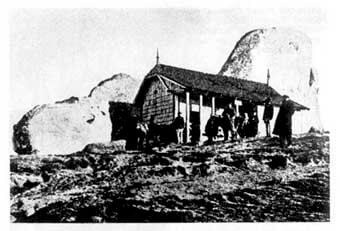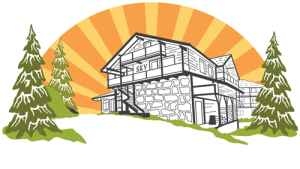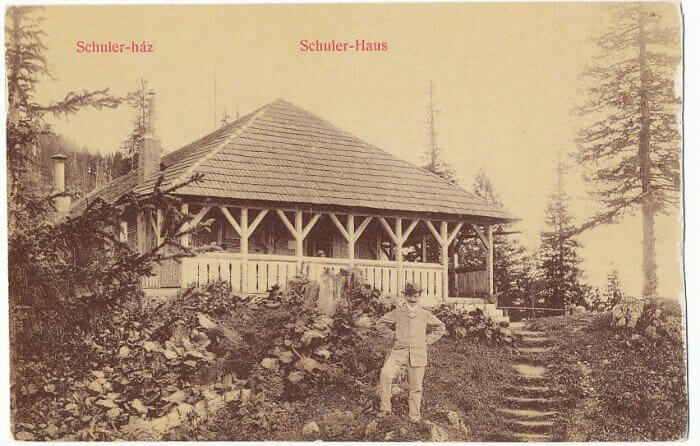Julius Römer Cottage – Postavaru
– founded at 1883
– altitude 1604 m (5262 ft)
– location: Postavarul Mountain, Poiana Brasov
– accommodation capacity: 100 places in rooms for 2-6 places
– dining room: 100 seats
“History is now. Why every generation writes its own history. But what most consider to be history is actually the result of this myth“. E.L. Doctorow
“History is the witness that confirms the passage of time, illuminates reality, vitalizes memory, provides guidance in daily life and brings us news of antiquity“. Cicero
Cristianul Mare or Postavarul (“mons gymnicus” in documents) was named in German (“Schuler”) probably based on the fact that forest income went to the school (Schule) or, better said, to the students (Schüler) of the Brasov school (scola coronensis) founded by Honterus in 1543, students who went annually, especially in august, on a trip to Postavarul and “had fun with jokes and games”. Trips “in this form” ended in 1716. School administration of Honterus allowed only once a month trips to the mountains (exire ad montes). Perhaps students have really been the first tourists of Brasov …
In 1857 two students of the upper (Eduard Gusbeth and Eduard Copony) had managed to klimb on the Postavaru in winter, which is exceptional for that time, commented and extensively discussed in newspapers as first winter ascents in Piatra Craiului Mountains in 1883, in Bucegi Mountains in 1884 and 1890 in Piatra Mare Mountains.
Brasov section of SKV build and marked two paths on Postavarul: “Red Path” that starts from the current “Capra Neagra” and “Blue Path” which starts at Krukur Crest on Tampa Mountains. To this was added in 1883, Postavaruls first hut built in the period 2 April 1881 – 7 October 1883. The cottage was originally called Schulerhütte – Schuler Hut, named after the Saxon name of the mountain. The hut was extended in 1891 (from 1885 Household and guarded during the summer, and starting in 1906 also in winter) that you can see today built-in current hut, being the oldest mountain shelter, which is still in function, in the country. In 1903 the so-called Pavilion was built and in 1907 an annex household.
At that time there was no dwelling house in Poiana Brasov. The land belonged to either the city or private individuals (Bobiţ, Lupan, Capaţana, Toropoiu, Govna, Ristea) or of institutions (St. Nicholas Church). There could only be seen here and there some hay barns. Tourism and skiing just animated this piece of nature, whose landscape has completely changed in a quarter century.
Ever since 1918, Brasov section chief of SKV (Dr. Gustav Philippi) predicted that “soon Brasov will be visited by more people. (…) The purpose of our association is open mountains through planning and commissioning of roads and by building a hut”.
There followed the implementation of a nice project: in august 1924 was opened current cottage “Ruia” – the first hotel in Poiana Brasov. The facade with windows facing south, comfortable and enjoyable dining room are a testament to the talented builder (architect A. Schuller).
By building training jumps (Poiana Mieilor) and increasing the jump from Poiana Mica – long time, the only jumps in the country – SKV promoted ski jumping …
Soon after Ruia, there were other buildings in Poiana. In 1924 “Turcu-Capatana” near Ruia, then several smaller private homes, villas and Scouts Cottage. On Postavarul was built in the ’30s IAR factory hut (Cristianul Mare Hut). Two new downhill trails were available: the so-called valley with telephone poles slope (today Sulinar Slope) for advanced skiers and a slope for families over Crucur and Drester to Poiana, then extended with the “Way of Taste” (Drumul lui Gust) to the city.
On the occasion of the 50th anniversary of Section Brasov in 1931 as a token of gratitude for the work submitted, the Administration of Brasov (Brasov City Hall today) donated to SKV the land on which they built the huts and its surroundings, an area 6 “jugare”. In 1933 they felt the need to have a bigger hut. After the plans of the engineer Frank G. were added two dining rooms, a bar, a ski wardrobe and a room for waxing skis. Work was funded by the Association and by donations campaign. There was made a lot of volunteer work – tens of thousands of bricks were brought in backpacks!
In 1935 took place in Brasov the 54th General Assembly of the Association, with whose occasion “the new hut” was sanctued, on September 1th, 1935 by the first priest, Dr. Konrad Möckel and was given the name “Julius Römer-Hütte” as praiseworthy honorary member Dr. Julius Römer.
A great mountain life began to develop in the Hut, where over many years “Postavarul parents” (Morawetz, Gust) led and guided to ski during the day and evenings to cottage activities, many tourists and ski enthusiasts. Skiers were like a big family. There was room enough for everyone in cabin and on the slopes … Back then there was still the original fairytale forest between the two cottages. They walked from Poiana to Postavaru … some even managed 2-3 daily descents.
In the very year of the inauguration, the hut was visited by the writer Mihail Sebastian that published years later his novel “The Accident” whose action takes place mostly in the cottage area. Surroundings, cottage, trails, slopes and weather atmosphere are described with great accuracy and charm and SKVs name is mentioned in the book a dozen times.
In 1945 Julius Römer cottage is nationalized and goes along with other SKVs huts to the new created National Tourist Office which was part of the Ministry of Propaganda. For 50 years the hut has hosted hundreds of thousands of tourists, slowly degrading, without much needed repairs, only cloth and dyed every now and then.
Immediately after reestablishment, the president Wolfgang Werner Fuchs SKV then followed by Johann Mantsch and priest Lothar Schullerus as mandated filed the documentation and efforts were made for restitution of the hut. By decision of 6 April 2004, the Society Poiana Brasov returns in kind to SKV the Postavarul Cottage and the related land. Administration of the hut is entrusted to Michael Sarbu, an old mountaineer, aided by his wife Florentina, reconditioning and repair work began and the Hut regains its friendly and familiar atmosphere played once. In the fall of 2004 the gas pipe is being completely rebuilt from Poiana to the cable car station, SKV beeing the main investor. Repair of the cottage and the installations continues under the leadership of Rolf Truetsch which thakes over the cottage in 2007 and helped by the whole familymade out of the renamed Julius Römer Cottage on Mount Postavaru great place and beloved it now is.
Out of the article of Professo Kurt Philippi „Das Märchen von Schilauf, Schulerau und Schuler“, appeared in Karpaten Rundschau, No. 4- 6 from January-February 1983, updated by Marcel Sofariu.
“History is the witness that confirms the passage of time, illuminates reality, vitalizes memory, provides guidance in daily life and brings us news of antiquity“. Cicero



